Background
On October 9, 2019, Turkish president Rajab Tayyip Erdogan announced the launch of “Operation Peace Spring” into northern Syria by Turkish forces and allied rebel groups in the National Army of the Syrian Interim Government, operating under the National Coalition for Syrian Revolutionary and Opposition Forces.[1]
Just a day before the start of the operation, the National Coalition for Syrian Revolutionary and Opposition Forces released a statement supporting the Turkish announcement of a looming military operation in the region. The statement said “The Coalition supports the efforts of the National Army, the Ministry of Defense and those of the Joint Chiefs of Staff. We confirm the readiness of our National Army to combat terrorism in cooperation and joint action with brothers in Turkey.” [2]
The Minister of Defense, Salim Idris, announced on October 7, that the National Army has completed the necessary training for the upcoming military operation in northeastern Syria.[3] This was preceded by other military arrangements, as the National Army and the National Front for Liberation announced their full integration on October 5, 2019.[4]
Turkey’s offensive into north-eastern Syria led to massive displacements, especially in its first few days. According to UN figures, 180.000 people displaced in the first two weeks of the operation-mostly women and children- 10.000 people of them entered Iraqi Kurdistan.[5]
Further, Turkey’s “Operation Peace Spring” was accompanied by violations and war crimes that were documented by UN bodies and international and local Syrian organizations. On October 15, 2019, spokesperson for the UN High Commissioner for Human Rights, Robert Colville, made a media briefing confirming the receipt of reports confirming the kill of Hevrin Khalaf. He considered that the incident could amount to a “war crime” with reference to the possibility that Turkey could be held responsible as a state for abuses committed by armed groups loyal to it, as long as Turkey effectively controls these groups, or the operations during which they occurred.[6]
Amnesty International, in turn, released a report on 18 October 2019, in which it confirmed that Hevrin Khalaf had been beaten and killed without pity. “Turkey is responsible for the actions of the Syrian armed groups it supports, arms and directs. So far, Turkey has given these armed groups the freedom to commit grave abuses in Afrin,” Amnesty International Secretary-General Komi Naidu said.[7]
1. What does this report present?
The present report provides information and detailed statements on three field executions carried out on October 13, 2019 by members of Ahrar al-Sharqiya in the National Army of the Syrian Interim Government, operating under the National Coalition for Syrian Revolutionary and Opposition Forces.
Victims of those executions are:
-
The nurse Medea Khalil Issa, born in Tell Abiad on August 5, 2001. She joined the medical staff of the Health Authority of the Autonomous Administration in 2017, and worked for the Military Hospital in Tell Abiad. Medea has also worked for two years as a volunteer for the Kurdish Red Crescent teams.
-
The ambulance driver, Mohammad Bouzan, 18, born in the city of Ayn al-Arab/Kobani, and a resident of the city of Tell Abiad. He worked in Tell Abiad Military Hospital as a surveillance cameras technician, but since the beginning of “Operation Peace Spring” he was appointed as an ambulance driver.
-
The escort to the ambulance, Hevi Khalil, who is a fighter in the ranks of Syrian Democratic Forces (SDF). STJ could obtain no additional details about Hevi’s death, despite its several attempts to contact people within SDF, but to no avail.
STJ had issued a detailed report on the execution of the well-known Kurdish politician Hafrin Khalaf and her personal driver, on October 12, 2019 (one day before the execution of the nurse Medea) by the same group, Ahrar al-Sharqiya.[8]
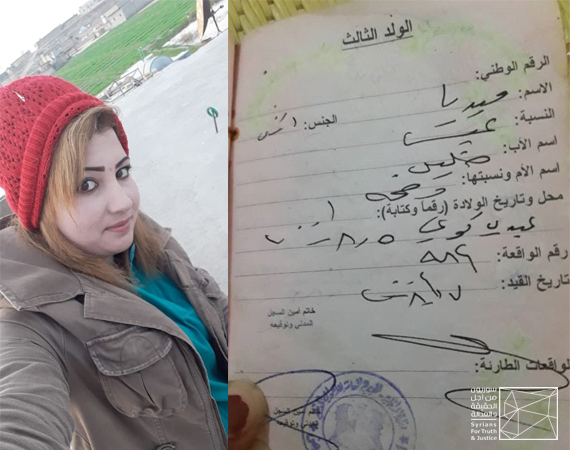
Image (1) on the right: Medea’s family book information. On the left: Medea’s photo. The document and photo were provided to STJ by the victim’s sister, Silva Khalil.

Image (2) on the right: a screenshot from a conversation between two people shows the body of Mohammad Bouzan (it was identified by his brother). On the left: Mohammad before his death.
STJ would like to note that the next photo has been circulated as being of the three victims, but it turned out that the two photos (on the left and the right) are of Medea, while the photo in the middle is of the driver Mohammad Bouzan, which means that there is no photo of Hevi in it.
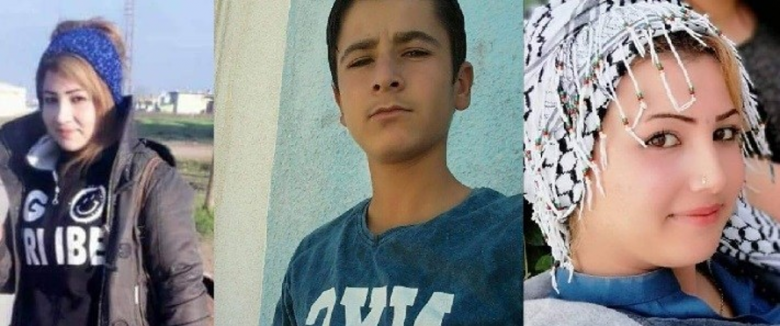
Image (3) two photos of Medea and one of Mohammad in the middle.
2. Methodology of the report
For this report, STJ met two individuals witnessed the executions and they both asserted that the perpetrators are members of Ahrar al-Sharqiya.
Families of the victims as well as two officials of the Autonomous Administration, one of whom works with the Kurdish Red Crescent and the second in the Health Authority of the Autonomous Administration, were also interviewed by STJ during the period between 10 and 23 January 2019. It also collected available open source evidence of the incident by a digital verification expert to ensure that Ahrar al-Sharqiya group was in Suluk on the same date as the executions.
3. Ahrar al-Sharqiya’s responsibility for the three executions
According to the information and statements collected by STJ, on October 13, 2019, members of Ahrar al-Sharqiya got in the way of an ambulance of the Kurdish Red Crescent near the town of Suluk, and immediately executed both its driver Mohammad Bouzan with a bullet to the head, and Hevi Khalil, who is a fighter used to escort the ambulance and was then inside the car. After their crime members of the group drove the ambulance to in front of al-Ahli Hospital and threw the bodies at its entrance and then executed the nurse Medea Khalil Issa, working in the hospital, before they left.
A civilian who witnessed the incident-he left the town of Suluk later- said to STJ field researcher:
“When the National Army began entering the town, we hid inside the hospital, we heard then an intense gunfire approaching, and saw a girl entering the hospital. When we attempted to leave, members of Ahrar al-Sharqiya stopped us and asked about our nationality; whether we were Kurds or Arabs, then they asked if we saw a girl hiding inside, we told them that we do not know and did not see anyone. I looked around and saw the corpse of a woman in military clothing and the body of a young man inside the ambulance. The members removed the bodies from the car and put them on the floor, and one of them entered the hospital and dragged the girl; she was screaming, I’m a nurse, I’m a nurse, but they shot her immediately and she fell dead.”
Another witness provides further details about the incident:
“When the National Army began entering the town of Suluk in the morning, we hid inside the house, as there were heavy gunshots and we did not know what was happening. When gunshots stopped, we heard the cries of men saying “Allahu Akbar” “Allahu Akbar”. I went out with my father to see what happened. I heard members of the group saying that there is a woman from the party hiding in the hospital. When one of the members noticed our presence, he shouted at us and told us to go back to our house. After that we heard gunfire “Allahu Akbars” again, but after about an hour we no longer heard anything. So, we went out to the street and saw two corpses, for girls one in a medical uniform and another in military suit (of SDF) and another for a young man lying on the ground.”
The witness added:
“Members of Ahrar al-Sharqiya did not allow us to bury the bodies and told us not to approach them, they left them thrown in the street for two whole days. However, after smells started to emit from the bodies, the people protested and asked for their burial. Then Ahrar al-Sharqiya members came with a large excavation vehicle and took the bodies to an unknown location.”
4. Accounts of victims’ families
Khalil Bouzan, brother of Mohammad Bouzan said on the incident:
“I heard several different accounts on my brother’s kill, but I never knew which one is true. Someone, who was then with Mohammad, told me that they were accompanied by 40 SDF fighters, but the latter abandoned them; actually, defected there ranks and joined the National Army group when the latter approached. Mohammad was killed by a sniper while driving the ambulance. I do not know what really happened or where Mohammad’s body is.”
STJ notes that it tracked the information received about the defection of SDF fighters and their accession to the National Army, but this information was found to be incorrect, which adds another confirmation to the accounts of the witnesses who were then at the Suluk Hospital, which say that the three people were field-executed successively.
STJ met Mohammad’s brother again-after about ten days-; he re-confirmed the inconsistencies in the accounts he heard on the killing of Mohammad and the absence of new/definitive evidence about the incident.
Silva Khalil, sister of Medea Khalil, said to STJ:
“I was informed about Medea’s death through an anonymous phone call; the caller first told me that Medea was in prison; the information was conflicted. However, I received later certain information from residents of the town of Suluk, who told me that Medea was killed there and buried in an unknown location. We did not get any photos of the bodies and we do not know where they were buried.”
STJ met, Juan Mustafa, the joint-head of the Autonomous Administration’s Health Authority in north-east Syria, he said:
“The three victims are members of the Health Authority staff. The National Army got in their way while they were transferring injured people near the town of Suluk. Information received about their fate was contradicted, but they have certainly been killed. It was reported that their bodies have been dumped in sewage.”
A member of the Kurdish Red Crescent said to STJ:
“We initially published news about losing contact with a group of medical workers, and then we began receiving contradictory and inaccurate information about them. They are workers in the Health Authority and not from our teams. We lost contact with them on the morning of 13 October 2019, so we haven’t got accurate information. We confirm that we did not find any bodies in the sewage and did not receive any information about the fate of the bodies.”
5. The presence of Ahrar al-Sharqiya members in the scene, at the moments of executions
On October 13, 2019, exactly at 6:43 AM, Ahrar al-Sharqiya published a tweet on its Twitter official account, saying that it had taken control of the entrance to the town of Suluk and attached the tweet with a photo of a masked fighter standing in front of a road sign saying “Welcome to Suluk”.
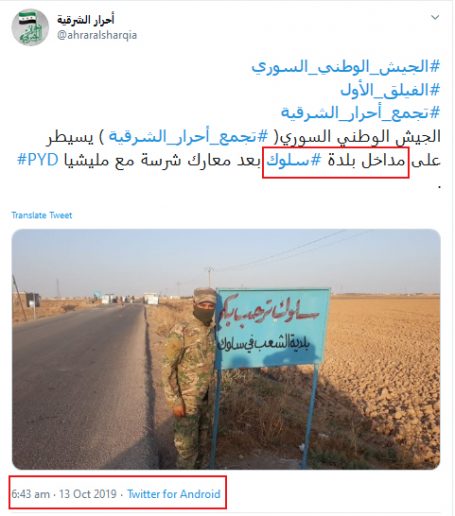
Image (4) a tweet published by Ahrar al-Sharqiya on October 13, 2019, declaring control of the entrance to the town of Suluk in Raqqa.
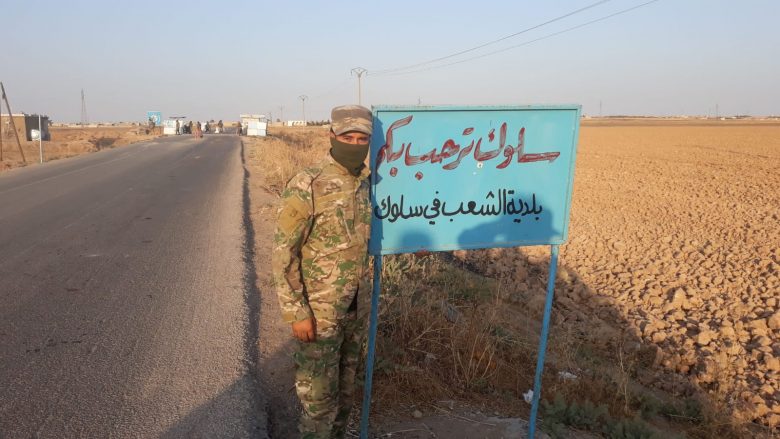
Image (5) a photo of a fighter attached to the abovementioned tweet.
On the same day, at 8:20 in the morning, Ahrar al-Sharqiya posted an 11-second footage, in which eight of its fighters appeared lining up at the main roundabout in the town of Suluk, carrying light weapons, and declaring full control of the town.
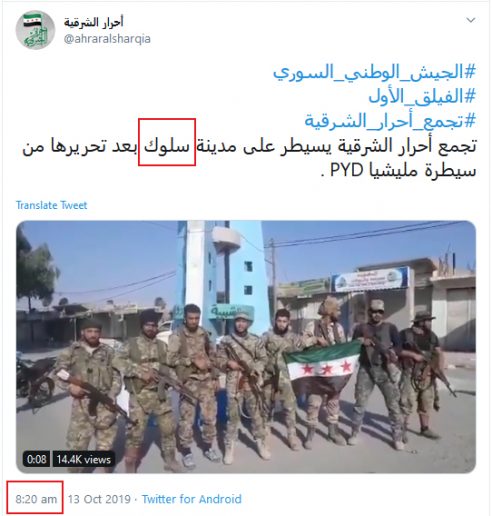
Image (6) a tweet published on the official Twitter account of Ahrar al-Sharqiya group, declaring full control of Suluk, in Raqqa. Oct. 13, 2019.
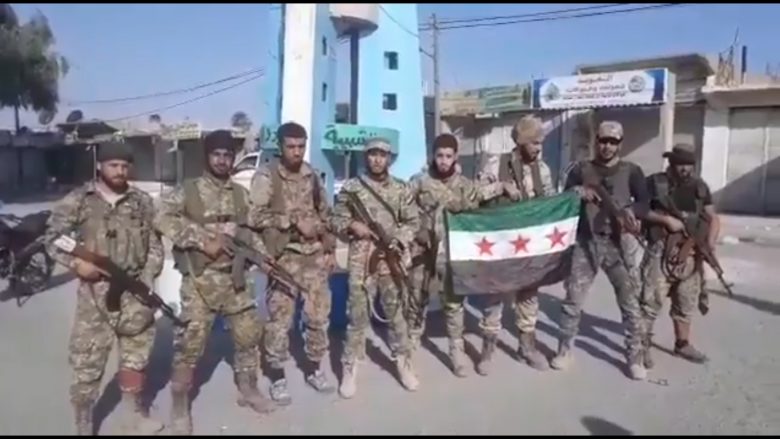
Image (7) the eight fighters appeared in the abovementioned footage.
Al-Ahli Hospital/Suluk Hospital, which entrance was the scene of the field-execution of the nurse Medea Khalil Issa, is located near the main roundabout of Suluk, where the footage was filmed. The execution took place during the first hours of Ahrar al-Sharqiya’s control over Suluk, according to witnesses, which suggests that fighters appearing in the footage were responsible for the executions.
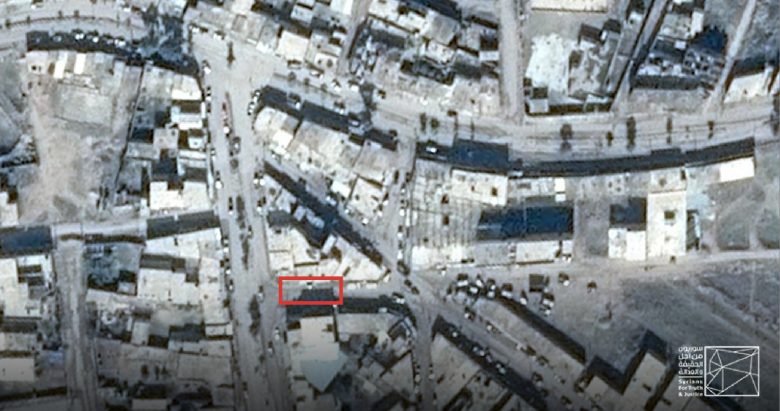
Image (8) the location of Al Ahli Hospital.

Image (9) the distance between the hospital and the location of Ahrar al-Sharqiya fighters when declaring control of the town.
Back to the victims’ issue, a photo of Mohammad Bouzan’s body dumped on a paved road/street with a man in military uniform standing next to him, was leaked. Mohammad has likely been killed by a bullet to the head, as blood gathers near his head.
STJ would like to note that this photo was the only to be leaked, so far, from the photos of the three victims’ bodies, and that it was taken anonymously in unknown time and location. It was shared for the first time in a private conversation between two people and was circulated on a small scale after it was taken as a screenshot.
STJ has talked to Khalil Bouzan, brother of Mohammad Bouzan, who identified the body in the photo and confirmed that he had never seen this photo before.
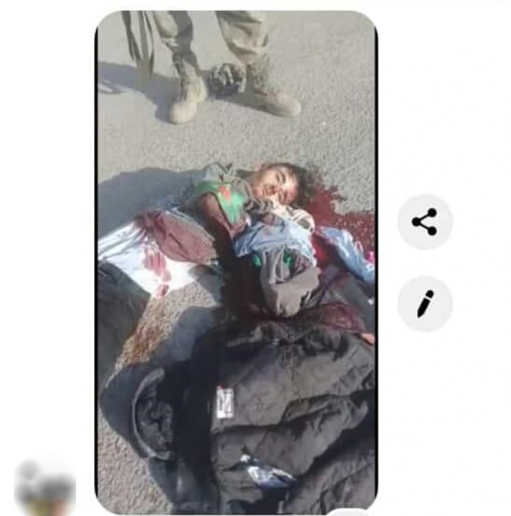
Image (6) body of Mohammad Bouzan, who was killed in an unknown time and location by Ahrar al-Sharqiya group near the town of Suluk.
STJ would also like to mention that the Kurdish Red Crescent published on its Facebook official account, on October 13, 2020, news about losing contact with a medical team of four people and two ambulances, and mentioned the names of the three dead Medea, Hevi and Mohammad. The post was deleted later, however. The Kurdish Red Crescent re-mentioned names of the three dead in a report published on its official website (see numbers 49, 50 and 51), saying that they were killed on October 10, 2019, but it did not mention the names in other reports that included lists of victims fell during the same time period.
[1] Erdogan in a tweet: “I would like to kiss the foreheads of all hero members of the Mohammadan Army, participating in “Operation Peace spring”, and I wish success to them and all the local supportive elements that stand side by side with Turkey in this operation, God bless you and was in your help”, Erdogan’s official Twitter account, October 9, 2019, (last visit: January 25, 2020) https://twitter.com/rterdogan_ar/status/1181927322271830016?s=20.
[2] “Syrian Coalition Reaffirms Commitment to Fighting Terrorism & Liberating Syria from Tyranny & Terrorist Orgs”, a press release by the Syrian National Coalition – Syria Department of Media & Communications, October 8, 2019, (last visit: October 22, 2019) http://en.etilaf.org/press/syrian-coalition-reaffirms-commitment-to-fighting-terrorism-liberating-syria-from-tyranny-terrorist-orgs.html.
[3] “National Army completes preparations for military operation east of Euphrates”, Yeni Şafak, October 7, 2019, (last visit: October 22, 2019) https://www.yenisafak.com/ar/news/3438458.
[4] “Merging the “National Army” with “The Front”: A Syrian Step Against Who?”, The New Arab, October 5, 2019. (Last visit October 22, 2019), https://www.alaraby.co.uk/politics/2019/10/4/%D8%AF%D9%85%D8%AC-%D8%A7%D9%84%D8%AC%D9%8A%D8%B4-%D8%A7%D9%84%D9%88%D8%B7%D9%86%D9%8A-%D8%A8%D9%80-%D8%A7%D9%84%D8%AC%D8%A8%D9%87%D8%A9-%D8%AE%D8%B7%D9%88%D8%A9-%D8%B3%D9%88%D8%B1%D9%8A%D8%A9-%D8%B6%D8%AF-%D9%85%D9%86-1.
[5] “UNHCR: Over 10,000 Syrians have crossed the Iraqi border since the start of the Turkish campaign in northeastern Syria”, UN News, October 25, 2019, (last visit: January 26, 2020) https://news.un.org/ar/story/2019/10/1042501.
[6] UN High Commissioner for Human Rights, Press briefing note on Syria, 15 October 2019, (Last visit: November 9, 2019), https://www.ohchr.org/EN/NewsEvents/Pages/DisplayNews.aspx?NewsID=25145&LangID=E&fbclid=IwAR3znXL03piDbs2BxH-o2lg3G3ZocybJYdgbbqmwdSODEbsMxq7WJ7ongQY.
[7] “Syria: Damning evidence of war crimes and other violations by Turkish forces and their allies”, AMNESTY, October 18, 2019 (November 9, 2019) https://www.amnesty.org/en/latest/news/2019/10/syria-damning-evidence-of-war-crimes-and-other-violations-by-turkish-forces-and-their-allies/
[8] “New Evidence Supporting the National Army’s Accusations in the Murder of the Kurdish Politician Hevrin Khalaf”, STJ, December 10, 2019, (last visit: January 25, 2020) https://stj-sy.org/en/new-evidence-supporting-the-national-armys-accusations-in-the-murder-of-the-kurdish-politician-hevrin-khalaf/#_ftn16


1 comment
[…] Human Rights Journalism […]